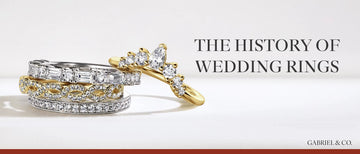
From ancient Egypt to modern times, the history of wedding rings reveals how these bands have evolved into symbols of love, commitment, and tradition. Along the way, we’ll uncover the customs, meanings, and artistry that shaped wedding rings through the centuries.
What is the origin of the wedding ring?

To find the first wedding ring, you have to go back to the banks of the Nile. In Ancient Egypt, wedding rings were exchanged as symbols of eternity. The circle represented endless life and love, while the hole in the center symbolized the unknown future a couple would enter together.
At first, these rings were made of reeds or papyrus. As Egyptian society prospered, lovers turned to leather, bone, and eventually gold, believing that precious metal mirrored the endurance of love itself. Egyptians also believed that a vein ran from the fourth finger of the left hand to the heart; the vena amoris, or “vein of love.” Though anatomically untrue, the idea was too poetic to abandon, and it spread far beyond Egypt’s borders.
How the ancient Greeks and Romans shaped wedding ring traditions

Centuries later, the Greeks and Romans borrowed and refined the custom. Greek wedding rings often featured Eros or Cupid, messengers of love, while ancient Roman wedding rings carried social and legal weight.
An iron band called the annulus pronubus was given as a sign of contract and fidelity. Later, as wealth and artistry grew, iron gave way to gold, and designs became more elaborate. Rings engraved with two clasped hands (dextrarum iunctio) symbolized union and good faith.
The Romans also believed in engraving inscriptions inside the band. Archaeologists have uncovered examples bearing words like “Amor vincit omnia”, love conquers all, a phrase that would echo through centuries of wedding ring symbolism.
Renaissance wedding rings: symbolism and romance intertwine

The Renaissance celebrated both intellect and emotion, and jewelry became a secret language of love. Rings often carried coded messages; acrostic designs spelled out words like "LOVE" or "DEAREST" using the initials of gemstones, while some bands hid miniature portraits, notes, or locks of hair. Among royalty, wedding rings symbolized alliance as much as affection. Queen Elisabeth of Habsburg’s wedding ring from the early 1500s, for instance, reflects the union of dynasties that defined European politics and love during this age.
The Georgian Era: The birth of sentimental jewelry

By the 18th century, emotion took center stage. Georgian rings brimmed with hearts, doves, flowers, and serpents, each carrying a coded meaning. The serpent, shown devouring its tail in the ancient symbol of the ouroboros, spoke of eternal devotion. Even mourning rings, worn in remembrance, served as promises that love endures beyond a lifetime. Handcrafted artistry and hidden symbolism made Georgian wedding rings deeply personal, which was the perfect prelude to the romanticism of the Victorian age.
The Victorian and Edwardian eras: The rise of romantic jewelry
During the Victorian era, wedding rings became deeply personal expressions of affection. Influenced by Queen Victoria’s romantic spirit, couples embraced symbolic motifs such as serpents, hearts, and flowers. Birthstones were often set into bands to mark anniversaries or shared meanings between partners.

As the Industrial Revolution advanced, jewelry production flourished, allowing more people to exchange gold bands as part of their marriage ritual. What was once reserved for the elite became a beloved tradition across all social classes.
By the Edwardian era, wedding rings reflected the refined elegance of the time. Jewelers began favoring platinum over gold, crafting airy, lace-like designs that captured the lightness and grace of early 20th-century fashion. The wedding ring had evolved from a simple promise into a tangible piece of art representing enduring love.

When did wedding rings become part of Christian marriage?
By the Middle Ages, the Christian Church had fully woven the wedding ring into its marriage ritual. What had once been a Roman symbol of ownership transformed into something far more spiritual, a visible sign of divine covenant and eternal love.
The earliest Christian use of rings dates back to around the 9th century, when the Church began blessing them during the ceremony itself. The circular band, with no beginning or end, was said to mirror the eternity of God’s love. Gold was favored not just for its beauty, but for its purity, representing faith and moral steadfastness.

In the Byzantine world, wedding rings often carried overtly religious imagery. One remarkable example from this era is a Byzantine marriage ring depicting scenes from the life of Christ that illustrates how faith and matrimony were inseparable. The figures engraved on the band served as both art and devotion, reminding the couple that their union mirrored divine love and sacrifice.
By the later Middle Ages, sentimentality and artistry intertwined. Posy rings carried tender inscriptions like “Two hearts, one soul”, hidden on the inside of the band where only the wearer would see. Gimmel rings, composed of two or three interlocking bands, were joined during the wedding as a symbol of two lives becoming one. Gemstones brought even more meaning. For example, blue sapphire wedding rings represented fidelity, rubies embodied passion, and diamonds reflected enduring strength.
What does a wedding ring symbolize?
The symbolism of wedding rings carries centuries of meaning. While every couple can make their ring uniquely theirs, some traditional associations have endured:
- Eternity and Unity: The unbroken circle represents love that has no beginning or end. Eternity wedding bands especially carry this symbol through the endless shimmer of diamonds along the band.
- Purity and Strength: Gold symbolizes enduring purity, while platinum wedding bands reflect resilience.
- Fidelity and Passion: Gemstones add layers of meaning—sapphires for loyalty, rubies for passion, and diamonds for lasting commitment.
-
Personal Connection: Engravings, hidden messages, or interlocking designs make the ring a personal story shared between partners.
Spiritual Significance: Historically, rings also reflected divine love, blessing, and covenant in religious traditions.
The meaning of wedding rings today
Wedding rings today carry meaning that goes far beyond tradition. While most people wear theirs on the left hand, some cultures favor the right, showing that even centuries-old customs can adapt.
Couples choose rings that reflect their personalities and lifestyles. Some prefer simple wedding bands that slip on effortlessly. Others like rings with subtle texture, mixed metals, or small engraved patterns that make the piece uniquely theirs. Personalized touches, such as engraving a special date, initials, or a short message, turn a circle of metal into a private story.
Styles have evolved to match modern values, too. Many opt for matching bands, while others intentionally pick different metals or finishes, showing individuality within a partnership. Regardless of the choice, the ring still represents commitment, continuity, and connection.

14K Yellow Gold 6MM Comfort Fit Wedding Band

14K Yellow Gold Diamond Wedding Band
Why are diamonds associated with wedding rings?
Until the early 1900s, diamonds were not a standard feature of weddings or engagement rings. That changed in 1947 when the De Beers company introduced the slogan “A Diamond is Forever.” The campaign transformed a gemstone into the ultimate symbol of eternal love and commitment.
The World Wars also reshaped wedding traditions. Soldiers wore plain gold bands as reminders of their partners at home. Many never took them off, giving rise to the tradition of men’s wedding bands, which became widespread after World War II.
By the mid-20th century, diamond rings were firmly established as the emblem of romantic promise.

14K White Gold Diamond Marquise Anniversary Band
A circle without end
Every wedding ring, whether it shines with diamonds or hums quietly in gold, carries echoes of the past; the reeds of the Nile, the iron of Rome, the whispered vows of the Middle Ages. It is the only piece of jewelry created not to adorn the body but to declare the soul.
In the end, the wedding ring is a story that keeps circling back, century after century, to the same eternal truth: love that begins, continues, and never ends.
FAQs
Why is the wedding ring worn on the “ring finger”?
The tradition dates back to ancient Egypt, where people believed a special vein, the vena amoris or “vein of love,” ran directly from the fourth finger of the left hand to the heart. Though anatomically untrue, the idea spread through Greek and Roman cultures and became a lasting romantic custom.
When did women start wearing diamond wedding rings?
Diamonds became popular in wedding and engagement rings during the 20th century, especially after the 1947 De Beers campaign, “A Diamond is Forever.” Before that, women’s wedding rings were usually plain gold bands or featured colored gemstones like sapphires and rubies.
When did men start wearing wedding rings?
Men’s wedding rings became common during World War II. Soldiers wore gold bands to feel connected to their partners back home, and the tradition continued after the war as a symbol of shared commitment.
When did engagement rings and wedding rings become two separate rings?
In early history, a single ring often represented both betrothal and marriage. By the Renaissance, separate engagement and wedding rings became fashionable, with the engagement ring given during the proposal and the wedding band added during the ceremony.
Do wedding rings have to match?
Not at all. While some couples love the symbolism of matching rings, others prefer styles that reflect their individual tastes.
Why do we wear wedding rings?
We wear wedding rings as visible signs of love, promise, and connection. The circular shape represents eternity, while the materials and designs carry personal and cultural symbolism passed down through centuries.
Written By: Gabriel Editorial Team






























